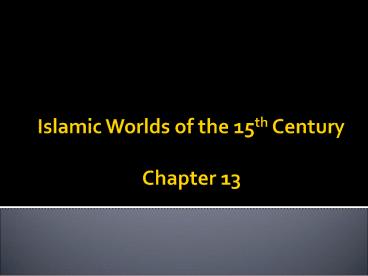Islamic Worlds of the 15th Century Chapter 13 - PowerPoint PPT Presentation
Title:
Islamic Worlds of the 15th Century Chapter 13
Description:
East of Ottoman Empire Modern-day Iran Lasted from 1501 to 1722 Ismail = Turkic founder of Safavid Dynasty Defining characteristic = followed Shia version of Islam ... – PowerPoint PPT presentation
Number of Views:400
Avg rating:3.0/5.0
Title: Islamic Worlds of the 15th Century Chapter 13
1
Islamic Worlds of the 15th CenturyChapter 13
2
Persian Empire (Safavid Persia)
- East of Ottoman Empire
- Modern-day Iran
- Lasted from 1501 to 1722
3
General Characteristics
- Ismail Turkic founder of Safavid Dynasty
- Defining characteristic followed Shia version
of Islam - Introduced sharp divide between Sunni and Shiite
Muslims to the heartland of Islam
4
Decline
- Incompetent Safavid rulers weakened the empire
- Poor leadership and misuse of money
- Territory was lost empire divided up when
Afghans seized Persia in 1722
5
Mughal Empire
- Located in India
- Kingdom center Delhi
- Established by Muslim Turks
6
General Characteristics
- Both Hindu and Islamic civilizations
- Muslim rulers
- Hindu subjects
7
Accomplishments under Babur
- Orderly government
- Expanded the arts
8
Accomplishments under Akbar the Great
- Brought peace and order to India
- Encouraged religious tolerance with both Hindus
and Muslims - Created a new religion called Divine Faith
combined Hinduism, Islam, and Christianity
9
Mughal Civilization
- Arts music, literature, painting
- Lavish courts
- Large libraries
- Built the Taj Mahal
- Increased trade
- Muslim architects introduced the dome and the
arch - Brought porcelain, paper, and gunpowder from
China to India
10
The Taj Mahal
11
The Taj Mahal
- Built by Mughal Emperor Shah Jahan
- Mausoleum for his 3rd wife
- She died giving birth to their 14th child
12
(No Transcript)
13
Mughal Decline
- Rulers abandoned religious tolerance and the
Hindu minority was persecuted, which weakened the
empire - Empire officially ended when Great Britain took
over India
14
Ottoman Empire
- Founded by Turks
- Started in Anatolia
- Controlled Balkan Peninsula and parts of eastern
Europe - Acquired much of the Middle East, North Africa,
and region between the Black and Caspian Seas
15
General Characteristics
- Maintained strong navy in Mediterranean region to
protect trade routes they controlled there - Conquered much of the Byzantines territory --
captured capital of Constantinople in 1453
renamed it Istanbul - Remained a significant sea power until the 1700s
16
Accomplishmentsunder Suleiman I
- Organized Ottoman law
- Strengthened military
- Converted young Christian boys to Islam drafted
them into the military called Devshirme - Janissaries elite infantry force
17
Accomplishmentsunder Suleiman I
- Islamic religious leader caliph
- Political ruler called a sultan
- Right-hand man to the sultan grand vizier
18
Ottoman Islamic Civilization
- Borrowed many elements from the Byzantine,
Persian, and Arab cultures - Bridges, mosques, and aqueducts reflect this
blend of culture - Turned Christian church of Hagia Sophia into a
mosque
19
Decline of the Ottomans
- By 1600, empire had reached its peak and started
to decline - Faced constant attacks from enemies on its
borders - Finally collapsed after its loss in WWI (it
fought with the Central Powers)































